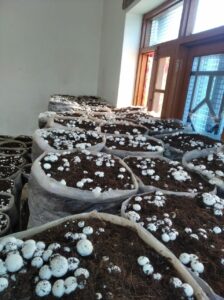A small village called Gangoo in Kashmir’s Pulwama district is where 22-year-old Neelofar Jaan supports her education with an interesting idea and driven efforts.
Currently pursuing her Master’s degree in social work from Indira Gandhi National Open University (IGNOU), she grows batch after batch of button mushrooms to support her family of four and combat the financial crisis that had posed a bump in her pursuit of higher education.
While earlier paying a semester fee of Rs 16,000 seemed like a distant dream, she now takes care of it with ease while also contributing to household affairs.
“We were going through a severe financial crisis, and I knew I had to do something about it,” says the young entrepreneur, whose house is often covered with clouds of white mushrooms.
Neelofar adds, “I took a one week course to learn the procedure of growing mushrooms at the Agricultural Department of Government Degree College of Pulwama. It was tough in the beginning, but through practice, I mastered the skill and began mushroom farming at home.”
It takes three months for her to grow one unit of mushrooms, which fetches her approximately 500 kg.
“I sell these in the local markets and earn an income of Rs 70,000 per month,” she reveals.

Neelofar’s success has encouraged her to continue mushroom farming even while pursuing a career with a local NGO.
Sharing her knowledge of how to grow mushrooms at home with The Better India, she outlines a five-point process:
- Use a grow bag and fill it with four layers of compost and seeds. “This layering should be alternate, meaning that one layer should be of compost and the next of seeds,” says this young cultivator.
2. Set the grow bags in a room away from sunlight. Due to a lack of chlorophyll, this fungus does not require light to grow.
3. Using electric heaters or other mediums, maintain the room temperature at around 30° Celsius during the growing period.
4. Neelofar says, “The compost layer tells you whenever it needs water by way of appearance. The top layer of the compost soil dries up as an indication of dryness.” To avoid this, consistently water the fungi twice a day.
5. During cultivation, ensure that no house flies or pests enter the room. “It is most important to grow mushrooms in a controlled environment. If left unchecked, such insects breed and feed on the crop, often leading to decay,” she warns.
No comments:
Post a Comment